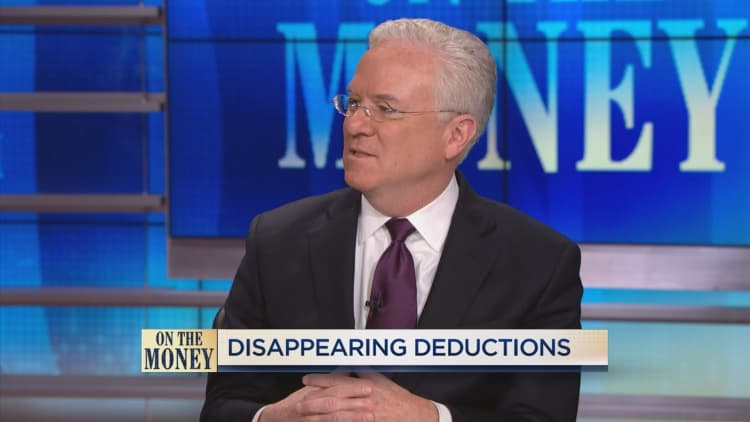
During the campaign, President Donald Trump proposed the most significant tax cuts since Ronald Reagan.
Trump's tax plan calls for reducing personal income tax rates from seven to three brackets: 12 percent, 25 percent and 33 percent. His plan also would increase the standard deduction to $15,000, up from $6,300 for single filers, and to $30,000 for married couples filing jointly, up from $12,600.
"For many middle-income taxpayers, the new standard deduction [under Trump's proposal] may exceed their itemized deductions, thus allowing a higher deduction," said Timothy Speiss, chairman of personal wealth advisors at accounting firm EisnerAmper.
The Urban-Brookings Tax Policy Center has estimated how much taxpayers would save annually based on their income under Trump's tax plan as well as a similar one proposed by House Republicans. (See chart below.)
Trump's plan also calls for the repeal of the alternative minimum tax and the estate tax. With the elimination of the AMT, itemized deductions would be worth more, Speiss said.
Under current law, a taxpayer can pass up to $5.45 million to heirs tax free. For married couples it's $10.9 million. Above that amount, beneficiaries must pay an estate tax of 40 percent. (Fifteen states and the District of Columbia also assess an estate tax.)
Only the wealthiest Americans pay the estate tax. In 2015, about 10,800 estate returns were filed, about half of those were taxable, with the federal government collecting $18 billion, according to Tax Policy Center estimates.
Not all taxpayers would benefit from Trump's proposals. His plan calls for repealing personal exemptions for taxpayers and their dependents as well as the head of household filing status.
If that happens, single parents with dependent children and most married households with at least three dependents would pay more in federal income taxes.
About 20 percent of households and more than half of single parents would pay more in taxes under Trump's tax plan even with the child-care breaks, according to an analysis by the Tax Policy Center from New York University law professor Lily Batchelder. (See table below.)
Trump's tax plan also caps itemized deductions at $100,000 for single filers and $200,000 for married couples filing jointly.
"The potential limitation of charitable contributions within the $200,000 framework is very controversial," Speiss said.
There is no guarantee, even with a Republican-controlled Congress, that these proposals will become law.
"Given the magnitude of these proposed tax cuts, Congress will have to compromise on some part of the plan," said Joseph Rosenberg, a senior research associate with the Tax Policy Center.
Potential members of Trump's Cabinet have said things that have conflicted with his tax proposals.
For example, Trump's pick for Treasury secretary, Steven Mnuchin, has said the tax plan would have "no absolute tax cut for the upper class," though most independent reviews of the proposal say it would.
So what can taxpayers do to prepare for possible tax reform?
"Whenever possible, defer any realized gains to down the road because we may have lower tax brackets during the Trump administration," said James Gambaccini, a certified financial planner and managing partner at Acorn Financial Services in Reston, Virginia.
Correction: An earlier version of this story gave the wrong location for Acorn Financial Services.


